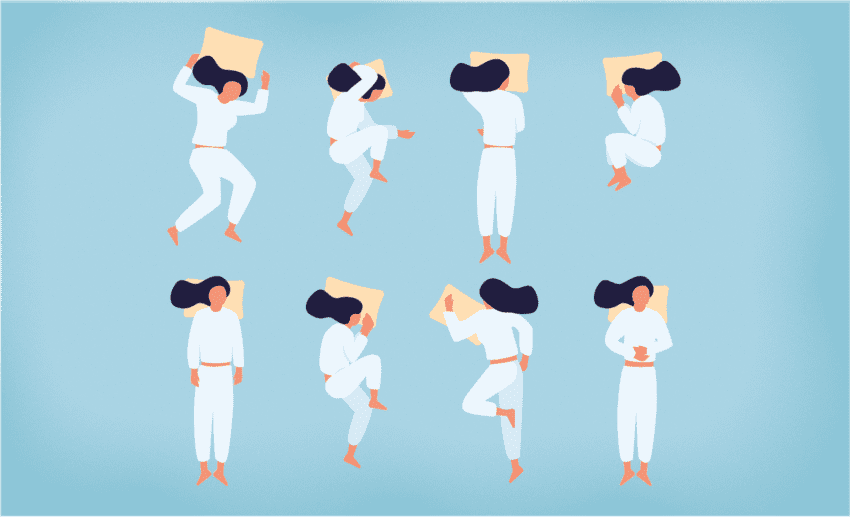If you wake up consistently in the morning with low back pain or tightness, you might attribute this to “sleeping on it wrong.” But it’s most likely not from one bad night’s sleep. Most causes of back pain do not come from a single event. Often, back pain is an accumulation of events that have been occurring over the course of a few months or years.
In this article, we’ll discuss how sleep can contribute to your spine health, so you can make changes to optimize your rest and improve the health of your back and spine.
Test Your Sleeping Knowledge
How can sleeping contribute to back pain?
From the alignment of the spine to the quality of mattress support, various factors influence how sleeping habits can either alleviate or exacerbate back pain. When the spine is not properly aligned or supported during sleep, it can lead to muscle tension, stiffness, and exacerbate underlying structural issues over time, resulting in discomfort and pain upon waking.
If you already have underlying back issues like herniated discs, spinal stenosis, or muscle strains, poor sleeping habits can exacerbate these conditions and increase back pain.
It’s essential to maintain proper posture during sleep, invest in a supportive mattress and pillows, and address any underlying sleep disorders or back problems with the help of a healthcare professional. Additionally, incorporating gentle stretching or mobility exercises into your daily routine can help improve flexibility and reduce tension in the back muscles while you sleep.
What is the best sleep position to alleviate back pain?
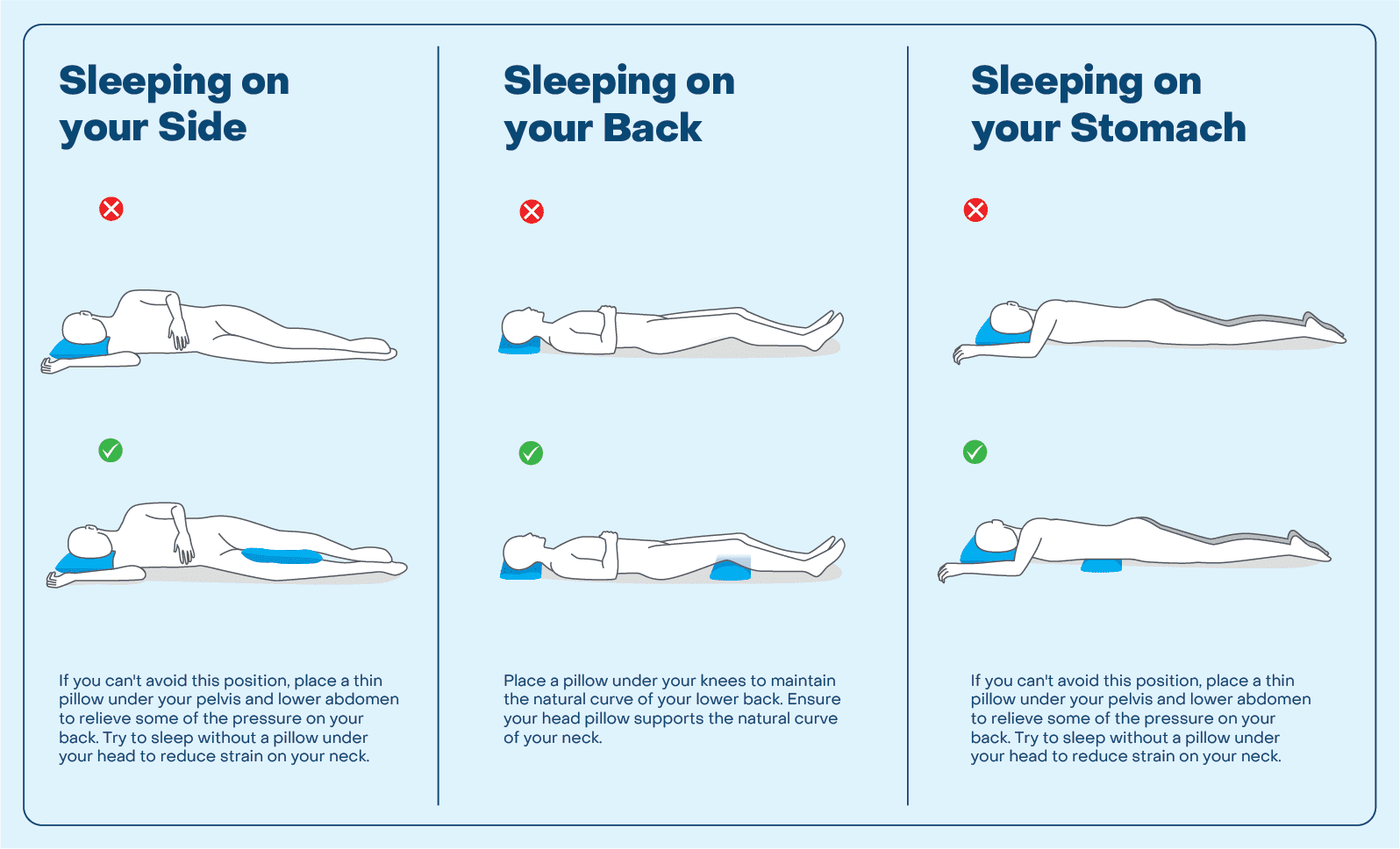
The key to sleeping well is to keep your spine naturally aligned. Whether you are a back sleeper or a side sleeper, understanding the alignment of the spine and maintaining that alignment while you sleep is a good starting point.
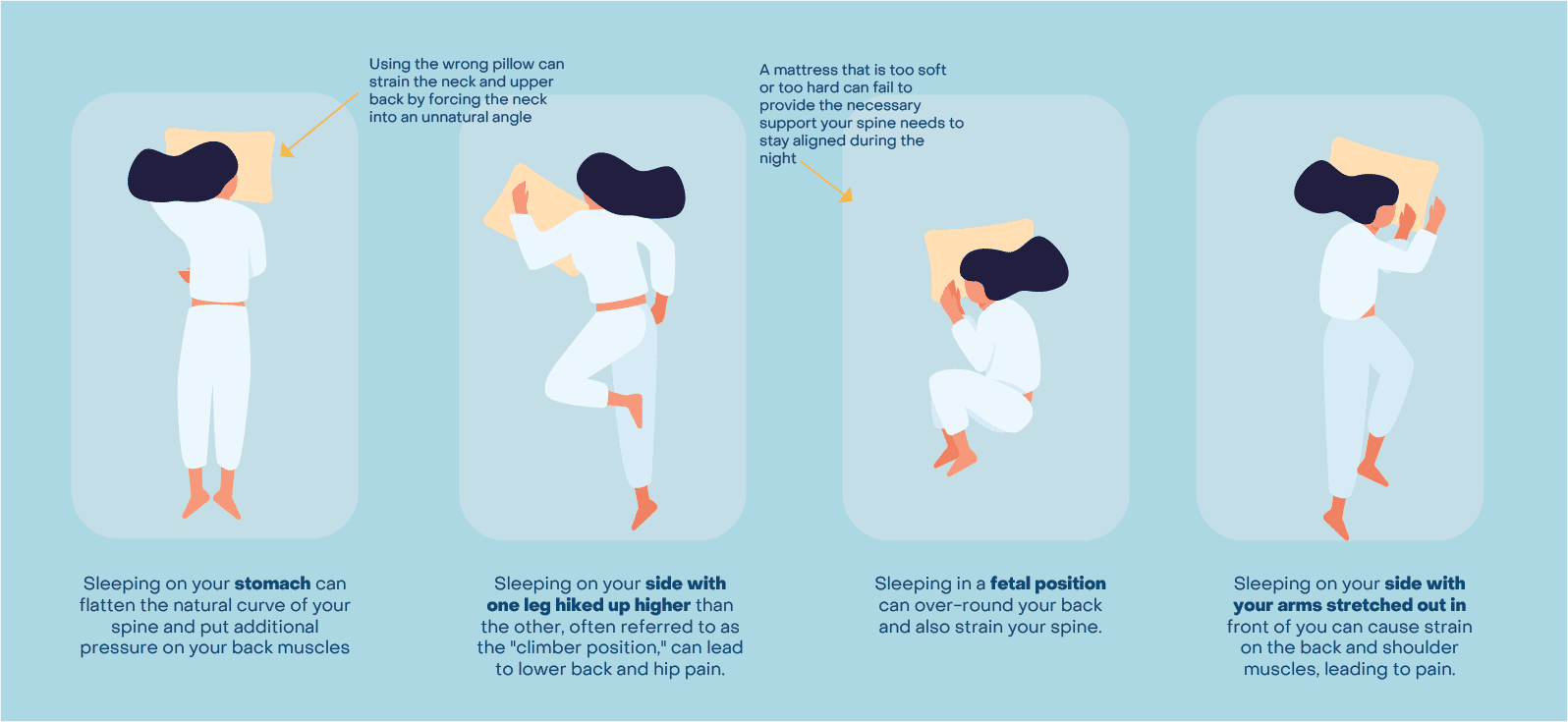
According to the American Chiropractic Association, sleeping on your back puts approximately 50 pounds of pressure on your spine! If you are a back sleeper, try putting a pillow behind your knees to reduce the stress on your lower back.
If you are a side sleeper, putting a pillow between your knees can keep the hips balanced. This can reduce pressure on your spine by nearly half!
Sleeping on your stomach is the sleep position that puts the most pressure on your spine because it counters the natural curves of your spine and forces you to turn your neck. This can cause neck and upper back pain.
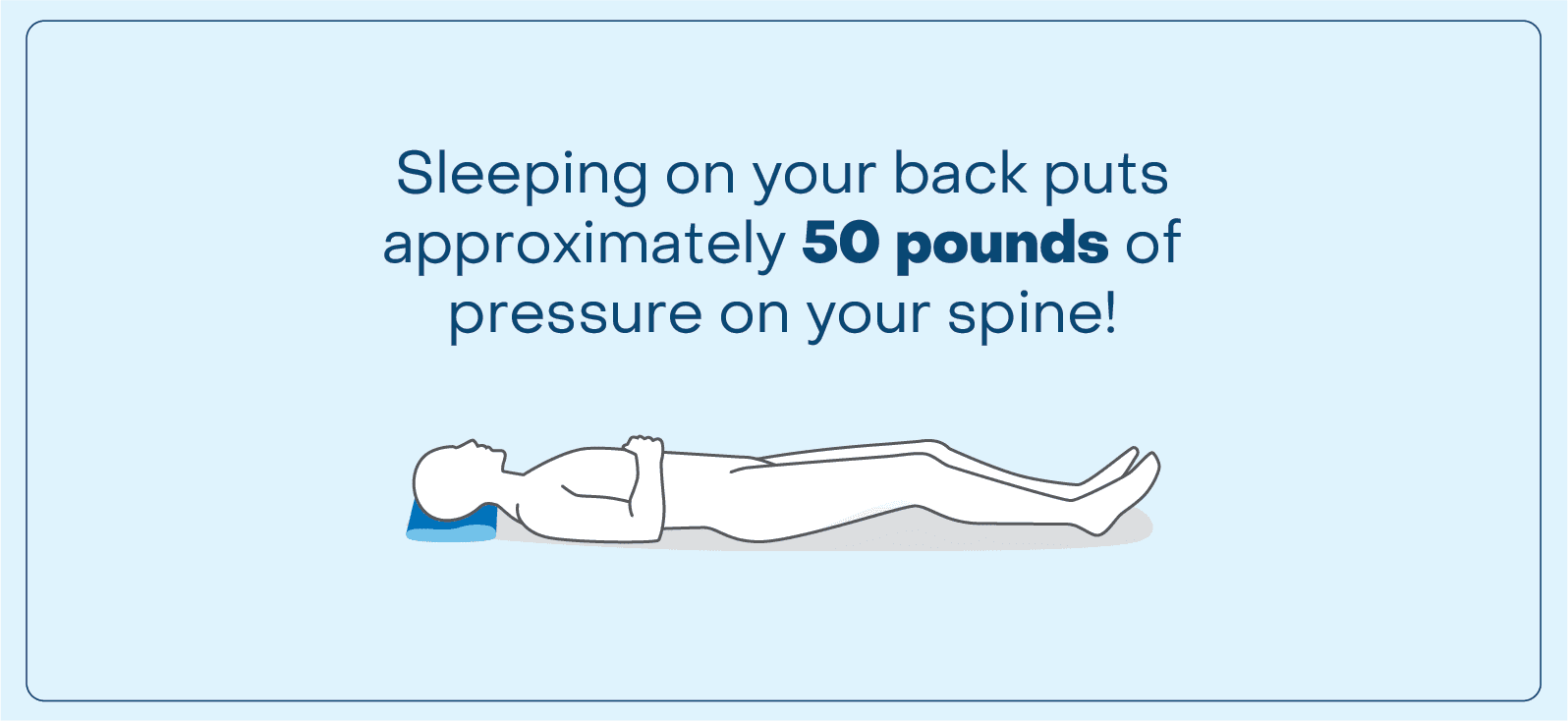
What mattress and pillow are best for back pain?
Lying down is the spine’s chance to finally take a rest after holding you up all day against the heavy weight of gravity. To make the most of this time, you need a comfortable mattress and pillow. Without it, there is no way to achieve proper rest.
A firm or medium-firm mattress provides support for the spine. This distributes pressure from the body more evenly, which causes less pain when lying down or after getting up. A soft mattress may feel comfortable at first, but often lacks enough support for adult-sized individuals throughout the night. If you prefer that softness, consider a firmer mattress with a soft mattress topper to achieve the best of both worlds.
Also, make sure to replace your mattress about every seven to ten years. Mattresses soften over time, which can prevent your spine from being naturally aligned while sleeping.
Look for lumbar support pillows. These cushions come in a handful of designs and can either be sat on or placed near the lower portion of your spine. This is meant to help keep your spine aligned while also making it comfortable for you to sit. You might also look to use a pillow with lumbar support for when you sleep. This can keep you from sleeping in positions that might cause pain or tension in your spine.
Another pillow that provides great spine alignment is a water pillow. Water pillows contain a pouch or chamber filled with water, typically surrounded by layers of padding or foam for comfort and support. These pillows are designed to provide customizable support and can provide pressure relief. However, do not use a water bed. These are extremely soft and do not allow for proper spine alignment.
Getting Enough Sleep
Getting enough sleep can be one of the most important ways to maintain your spine’s health. Adults should aim to get between 7 to 9 hours of sleep per night. You may need more if you are recovering from surgery or an acute illness.
Sleep hygiene includes reserving your time in bed to when it is time for sleep. Using the bed for non-sleep activities such as watching shows or browsing on your electronic devices make it more difficult to fall asleep.
When you lie down, the weight of your body is more evenly distributed, alleviating the strain on your spine that may occur from activities during the day. During sleep, the body undergoes a process of tissue repair and regeneration; adequate sleep allows for the repair of damaged spinal tissues, like muscles, ligaments, tendons, and spinal discs. This helps maintain the overall health and integrity of the spine.
Sleep also allows the muscles surrounding the spine to relax fully. During deep sleep stages, the body experiences muscle atonia, a state of complete relaxation of voluntary muscles, which promotes deep relaxation. This relaxation helps alleviate tension and reduces the likelihood of developing muscle imbalances or strains that can contribute to back pain.
Lack of sleep has actually been associated with increased sensitivity to pain. Chronic sleep deprivation can lower the pain threshold, making individuals more susceptible to experiencing discomfort, including back pain. Conversely, getting enough sleep can help manage pain by reducing inflammation and improving pain tolerance.
Chronic sleep deprivation has also been linked to an increased risk of developing chronic illnesses. One study found that long-term poor sleep quality contributes to a substantially increased risk of chronic and disabling back pain – irrespective of what activities participants did during the day. Sufficient sleep may help prevent or delay the onset of these conditions.
What to Do When Back Pain Keeps You From Sleeping
Sleep problems are frequently cited as an unwelcome consequence of back pain. When back pain keeps you from sleeping, there are several strategies you can try to alleviate discomfort.
First, experiment with different sleeping positions. The sleep position you used most frequently before the onset of back pain may not be one that works for you anymore. If you were a back sleeper, try sleeping on your side; and vice versa.
If adjusting sleep positions, sleeping on a firm mattress, and trying body support pillows don’t provide enough relief, try applying heat or cold to your back before bedtime. This can help reduce inflammation and alleviate pain.
Additionally, stretching before bedtime and relaxation rituals like meditation can help relax tense muscles and improve flexibility. Research has shown that yoga or intensive stretching can help reduce low back pain. Here are three simple stretches you can do before bed to relax your body and alleviate any back pain:
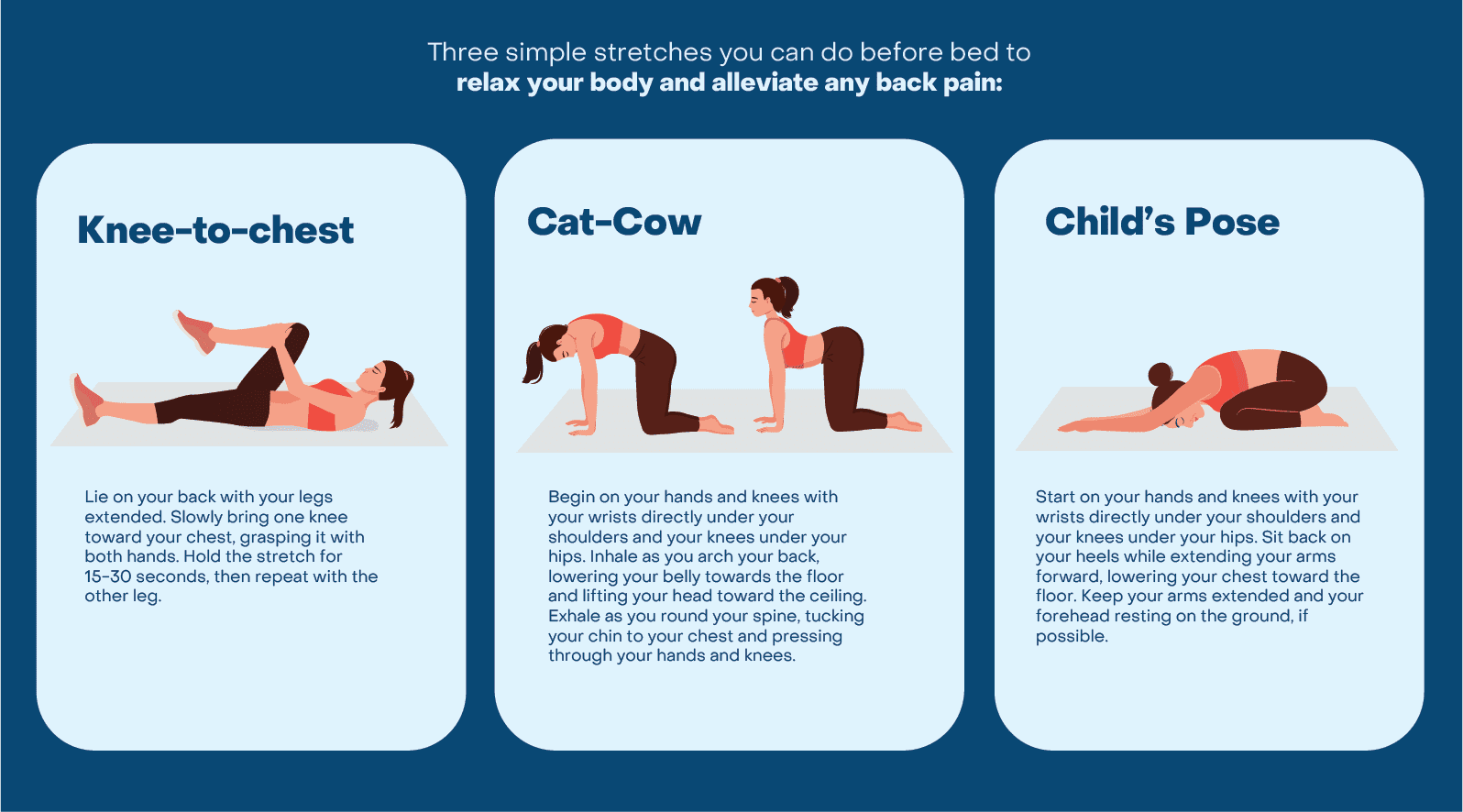
- Knee-to-chest: Lie on your back with your legs extended. Slowly bring one knee toward your chest, grasping it with both hands. Hold the stretch for 15-30 seconds, then repeat with the other leg.
- Child’s Pose: Start on your hands and knees with your wrists directly under your shoulders and your knees under your hips. Sit back on your heels while extending your arms forward, lowering your chest toward the floor. Keep your arms extended and your forehead resting on the ground, if possible.
- Cat-Cow: Begin on your hands and knees with your wrists directly under your shoulders and your knees under your hips. Inhale as you arch your back, lowering your belly towards the floor and lifting your head toward the ceiling. Exhale as you round your spine, tucking your chin to your chest and pressing through your hands and knees.
Learn more yoga poses for lower pain pain here, or watch this video.
Sleep after Spine Surgery
Sleep is essential for the body’s natural healing processes. Your body needs extra rest when recovering, because it’s over time and expending energy to heal.
Sleep promotes the release of growth hormone, which aids in tissue repair and regeneration. This is crucial for healing incisions, repairing damaged muscles, ligaments, and tendons, and facilitating the repair of bones.
Sleep also helps your body maintain a strong immune system, which is crucial for preventing postoperative complications, like infections. It also improves your body’s response to rehabilitation exercises and physical therapy.
Tips for Post-Surgery Sleep:
- After surgery, avoid excessive caffeine and keep your body moving throughout the day when possible to ensure a restful night’s sleep.
- Use the log-rolling technique to turn in and get out of bed. The goal is to avoid twisting the spine – move your body as one unit.
- If you sleep primarily on your back, place a cylinder roll or pillow under your neck and a flat pillow under your head so the overall alignment of the neck and spine is neutral.
- If you sleep on your side, be sure the size of the pillow under your head does not force the neck into a bent position, and place a firm pillow between the knees.
Conclusion
Prioritizing good sleep hygiene is important for maintaining optimal spine health. Poor sleep habits can exacerbate back pain, slow recovery, and affect your overall quality of life.
By understanding the importance of proper sleep posture, investing in supportive mattresses and pillows, and learning some simple exercises to do before bed, you can give yourself the best chance possible for a restorative night’s sleep.
